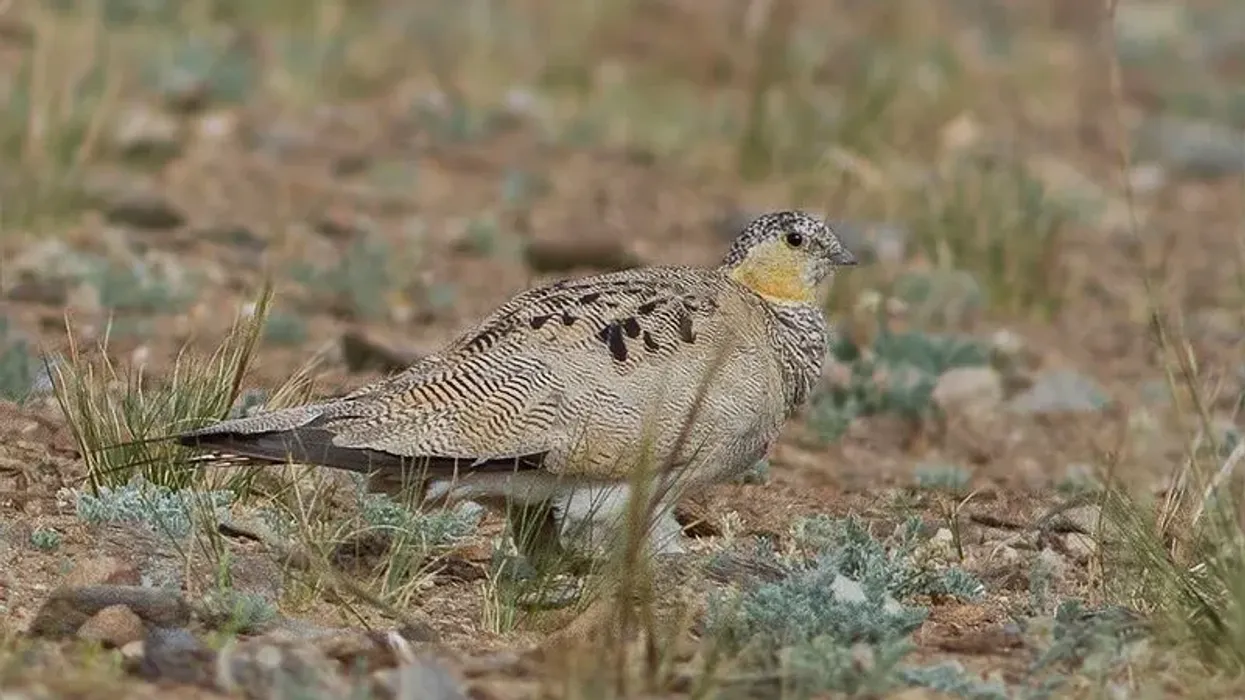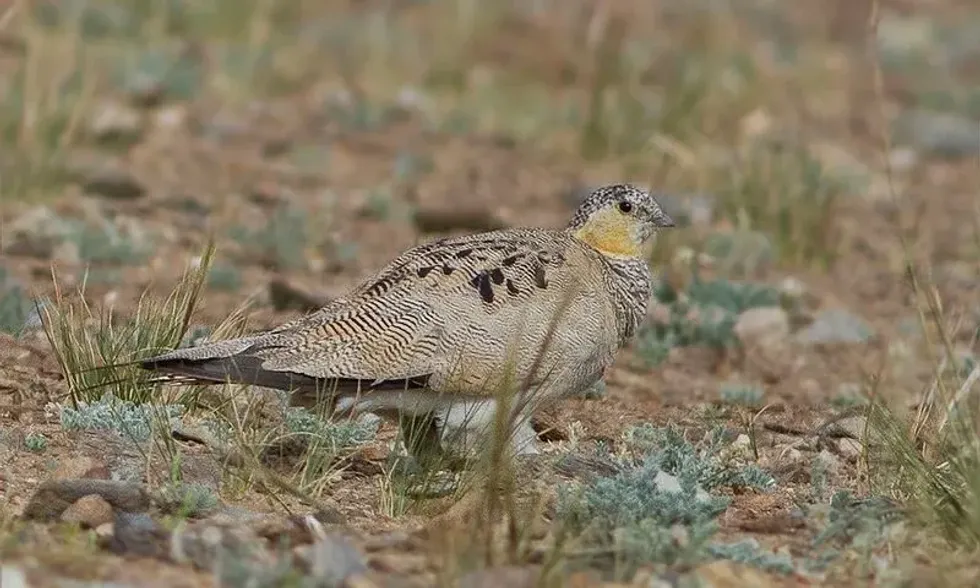The Tibetan Sandgrouse (Syrrhaptes tibetanus) and belongs to the order Pterocliformes kingdom under the authority of Gould 1850 and belongs to the genus Syrrhaptes. The Tibetan sandgrouse is a large bird and can be mistaken to be related to a pigeon cause of their similarities looks-wise.
The only way for identification is the difference in shades of colors that a sandgrouse has. The taxonomy of this bird states that they are a monotypic species and they belong to the animal kingdom which flies and migrates in order to survive.
The distribution of this species is mainly in the areas on the world map of Central Asia, Tibet, Central China, and the Himalayas. They tend to stay near arid, upland plains, mountains and inhabit plateau areas that are barren and yet have water bodies.
They move in flocks and only tend to separate when the mating season arrives. The Tibetan sandgrouse is an altitudinal migrant bird species and they move around for food and to breed.
In times of winter, they move to lower altitudes. They weigh about 0.659-0.870 lb ( 299-395 g) and are 11.811- 16.141 in (30-41 cm) long.
If you want to discover more like the Tibetan sandgrouse, then check out other articles on greater sage-grouse facts and western kingbird facts.
Tibetan Sandgrouse Interesting Facts
What type of animal is a Tibetan sandgrouse?
The Tibetan sandgrouse is a medium-sized bird in the Sandgrouse kingdom family and is primarily ground-feeding birds. The taxonomy of this bird states that they are a monotypic species. The species was first described by Gould, 1850, based on a specimen noted from Tso-Morriri in Ladakh.
What class of animal does a Tibetan sandgrouse belong to?
The Tibetan sandgrouse (Syrrhaptes tibetanus) belongs to the class Aves and is in the order of Pterocliformes under the authority of Gould 1850 and belongs to the genus Syrrhaptes.
How many Tibetan sandgrouse are there in the world?
There isn't an exact amount that has been calculated but there has been a stark decline in the population of the sandgrouse birds in certain areas.
Due to the rise in urbanization in the world and change in the climate, the population of various bird species and the sandgrouse birds too face problems of lack of water or less nature to reside in.
Where does a Tibetan sandgrouse live?
The Tibetan sandgrouse bird populations make their habitats in upland plains and they tend to choose common areas that are arid and yet have sufficient water bodies. They look for food during the morning and afternoon in treeless, semi-terrain regions and move in flocks to water bodies in order to be safe from predators.
What is a Tibetan sandgrouse's habitat?
The distribution of this species could range from Central Asia, Tibet, Central China to the Himalayas. The mountains and semi-terrain regions, plateau, plains near water bodies, and sandy regions are perfect habitats for the sandgrouse birds.
Who do Tibetan sandgrouse live with?
These birds tend to live in flocks in order to be safe from predators. Despite being a smaller bird they are not a frequent preyed upon species.
The only time they separate in groups is when it's mating season. In order to keep themselves safe, the sandgrouse species tend to stay in flocks or call upon other sandgrouse birds before watering so those wild animals can't prey on them while they are soaking or drinking water.
How long does a Tibetan Sandgrouse live?
The Tibetan sandgrouse (Syrrhaptes tibetanus) has a life span of about five to eight years.
How do they reproduce?
The sandgrouse species breeding season starts during the summer of earlier June and spring season and after breeding, they lay about three cryptic eggs in the ground which has a slight depression and has a few foliages.
The task of incubating is divided amongst the male and female sandgrouse and the male might incubate during the day while the female during the night and vice versa.
The eggs hatch after about 20-25 days and as soon as the hatchlings are all out they can leave the nest. After this, the parent sandgrouses teach the newborns all the necessary skills to survive and as they stay in flocks the chicks end up staying with the parents till they are of age for breeding.
What is their conservation status?
According to the IUCN Red List, the Tibetan sandgrouse is of Least concern as even though there has been a decline, it hasn't reached the point of being Vulnerable.
It is quite difficult to keep the rise in population of these species in check as they somehow look related to the common pigeon and it is quite difficult to differentiate them even in appearance until looked at closely.
Tibetan Sandgrouse Fun Facts
What do Tibetan sandgrouse look like?

The Tibetan sandgrouse male is much bigger and colorful than the Tibetan sandgrouse female and this makes it sexually dimorphic. Their upper feather is more on the softer brownish-yellow side and has black shades which enable them to merge into the landscape they forage in.
The head of the sandgrouse is small and their wings are long. The face and the neck are of the shade orange.
The middle of the body, the breast and crown, is gray. The difference between the male and female sandgrouse species is that the wings of the male Tibetan sandgrouse are unspotted and pale yellow-brown whereas the female wings are finely barred and vermiculated gray.
Their bellies are white and the underwings are black in color much like the Pallas's sandgrouse. Along with these, they have a long tail which makes the feather look long and pin-like.
They have rough skin and the quality of absorbing water in their belly makes the Tibetan sandgrouse species helpful when the chicks need water till they are able to fly.
How cute are they?
These species are not pretty like the calliope hummingbird, but surely their orange vibrant color makes them quite likable.
How do they communicate?
Like any other bird species, the Tibetan sandgrouse (Syrrhaptes tibetanus) tends to communicate through movements and sounds but can also make different types of sounds to show different emotions. Also, they move in flocks which makes it easier for them to communicate.
How big is a Tibetan Sandgrouse?
A Tibetan sandgrouse (Syrrhaptes tibetanus) is a medium-sized bird that is 11.811-16.141 in (30-41 cm) long. A vulture is 51.18-110.23 in (130-280 cm) long which makes the Tibetan sandgrouse almost six times smaller than a vulture.
How fast can a Tibetan Sandgrouse fly?
The exact speed hasn't been calculated but with their big wings and feathers, this species surely can outfly a few predatory birds.
How much does a Tibetan Sandgrouse weigh?
The Tibetan sandgrouse (Syrrhaptes tibetanus) weighs about 0.659-0.870 lb ( 299-395 g).
What are the male and female names of the species?
There are no sex-specific names associated with this species.
What would you call a baby Tibetan Sandgrouse?
The newborns of the Tibetan sandgrouse (Syrrhaptes tibetanus) are just called hatchlings or chicks until they mature to be adults. The newborns are fed worms by the adults until they become independent.
What do they eat?
The Tibetan sandgrouse's diet primarily consists of seeds and this bird forages on berries, green shoots, leaves, and bulbs. In some cases, they feed on ants and wasps, especially during the winter season.
Are they poisonous?
The Tibetan sandgrouse's personality is quite friendly and these species of birds don't retaliate until they are attacked. They don't have any venom but like any other bird species, they will try to defend themselves by flapping their wings and hitting the attacker with their beak and claws or choosing to flee in cases of danger.
Would they make a good pet?
Not all species can survive when captured as pets and sandgrouse birds being animals that survive in flocks and fly around all over the map from the north to south, from one country to another, don't do well when are tried to be kept as pets. More than often they can die due to captivity.
Did you know...
The Tibetan sandgrouse (Syrrhaptes tibetanus) stays in flocks of 100 or more birds and doesn't separate at all. When these species need to go to water bodies, they call out to the flocks so that they can together go to watering holes at odd hours in order to be safe from predators.
What's the difference between a Tibetan sandgrouse and a pheasant?
Pheasants belong to the family Phasianidae and are 24–35 in (60–89 cm) long. The sandgrouse, on the other hand, belongs to the family of Pteroclidae and is 11.811- 16.141 in (30-41 cm) long.
The pheasant is a much more vibrant species bestowed with different colors while the Tibetan sandgrouse species identification is easier as it is vibrant as well but its brownish-yellow shade of color makes it easy for it to blend in with the area it resides in.
What's unique about the Tibetan Sandgrouse?
The Tibetan sandgrouse (Syrrhaptes tibetanus) habitats in dry regions and have a dry diet as well, which makes them drink more water.
These birds have feathers all over their body and the belly feather has the ability to absorb water and this is what makes them the most unique as water bodies can be 1000 miles away and carrying the water back to the newborn birds becomes easier when it gets absorbed.
Here at Kidadl, we have carefully created lots of interesting family-friendly animal facts for everyone to discover! Learn more about some other birds including leghorn chicken facts and bobwhite quail facts.
You can even occupy yourself at home by coloring in one of our free printable lemon dove coloring pages.
Main image by Dibyendu Ash.
Second image by Kulbhushansingh Suryawanshi.








